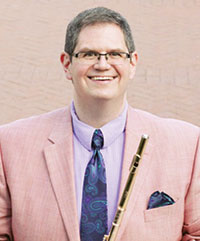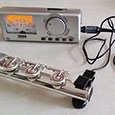.jpg) Today you will find an adult flute choirs in most cities across the U.S. Some are affiliated with a university, but many are stand-alone groups. The one in my city is a stand-alone. Each Monday night eighteen flutists rehearse for 90 minutes from September through early June and play six to ten concerts and events per year. The flutists come from all professions – music teachers, CPAs, doctors, realtors, nurses, and public school teachers – and their ages span more than 50 years.
Today you will find an adult flute choirs in most cities across the U.S. Some are affiliated with a university, but many are stand-alone groups. The one in my city is a stand-alone. Each Monday night eighteen flutists rehearse for 90 minutes from September through early June and play six to ten concerts and events per year. The flutists come from all professions – music teachers, CPAs, doctors, realtors, nurses, and public school teachers – and their ages span more than 50 years.
We selected Mary Stolper and Timothy Hagen as the first masterclass teachers. Stolper is principal flute of the Grant Park Orchestra in Chicago and a retired flute professor at DePaul University. Hagen is the flute professor at the University of Wisconsin-Madison. Both asked what we hoped they would do with our group. Our response was that while most of the players had excellent band training, many had not had the opportunity to study with an artist teacher. Simply, we wanted to play the flute better and play musically. These are the notes from the two classes.

Mary Stolper
Stolper began the class with having everyone play in unison, a descending half-step quarter note slurred to a dotted quarter note with a taper on the end. The diminuendo was not as controlled as hoped. Stolper reminded, “When you go softer, you tense your armpit muscle. Relax your armpits.” We repeated the exercise, and the improvement was noticeable. She asked, “Why do we warm up?” She suggests we warm up to warm up the muscles of the face. She remarked that she keeps a spare headjoint in her car; so, when stuck in traffic, she warms up on it. She suggested that we remember “to aim the air up over the steering wheel.”
When talking about the embou-chure, she advised taking a button with four holes in the center. In the holes tie some heavy thread so that the button can be placed in the mouth behind the lips, and then the string is pulled out from the face. She said this is a way to understand how to use the muscle around the opening or aperture in the lips. She recommended thinking of an ice cream cone with the scoop of ice cream in your mouth and the air channeled or directed to the tip of the cone.
When discussing the aperture, she advocated thinking of the aperture as a clock with 12:00 on the top. Then, in focusing the tone, think of bringing 12:00 and 6:00 closer together and/or 3:00 and 9:00 closer together. By naming the areas, the flutist has a better idea of what to move to achieve the desired results.
With any ensemble, playing dynamics is an issue. Stolper proposed warming up in all registers of the flute and to practice all dynamic levels. To learn to play softer, she had the group start a note very softly and then become even softer and hold that level. After a breath, come in on that new lower level and go even softer and hold at the end. We repeated this many times. It was like coming down stair steps but each time you started softer and concluded softer. We were all pleased at our new-found softer levels of playing.
Playing appropriate dynamics in a chamber ensemble is always an issue. She divided the group into two parts. One group played Twinkle slurred/legato and the other staccato. Then she assigned dynamic designs for each group. The legato group started softly and with each phrase became louder while the staccato group did the opposite. As we played we could hear one group coming forward with the dynamic as the other receded. This was a powerful example of what can happen when you play too loudly – you cover up the good stuff. Stolper reminded the players that you must practice the difficult parts so you can bring more to the group.
One of the flutists asked about intonation. She pointed out that two notes can be in tune but yet not sound in tune if the players are not constructing the notes with the same vowel shape in the mouth. She wrote ah, ei, i, o, u and oo on the board. She said that you cannot tune with the i or the e vowels and primarily worked with the o vowel shape in the mouth. This immediately cleared up the intonation in the group.
Stolper’s teaching was garnished with props. For example, if a flutist played a very bright top octave E, she put on her sunglasses. The flutist got the idea immediately.

Timothy Hagen
Once again, the class started with a discussion on intonation. Hagen said that he had once told himself, “I am tired of being bad at this, so now is the time to fix it.” Intonation is for your ears, not your eyes. Use the tuner as a drone. Be sure to have a good set up and play with a great sound. He said some flutists are not sure whether they are flat or sharp and suggested putting adjectives to each. He said to work intervals for intonation from unisons to octaves, then thirds and fifths and finally scales.
It is okay to play something out of tune on purpose for analysis. We began working on first octave G until everyone in the room was in tune. Then half added a B, making it a little flat until the interval rang. For the D above the G, we raised the pitch slightly. He pointed out that each note has a different function in each key. For example, a G above a C will be higher, yet a G after an Eb will be lower.
Hagen also talked about the top octave, sharing that his teacher Marianne Gedigian said that the third octave is the money register. To have a great top octave, a flutist should have solid fundamentals in the first octave. Success in the top octave is a combination of having the correct air speed and the correct angle of air. Hagen took us through several octave exercises to work on this idea, which he referred to as the Goldilocks concept. When the combination is in the correct proportions, the results will be just right. When working on this he shared Gedigian’s words of wisdom, “You are what you breathe.”
One of the most interesting parts of the masterclass was when one of the flutists asked about what he learned from various teachers he had studied with through the years. He began with Tina Ballard, one of his first teachers, who taught him the concept of the Five Pennies. This practice technique is one that has been golden through the ages and can be traced back to various violin pedagogues. Five pennies are placed on one side of a music stand. Each time you play the exercise correctly, you move the penny to the other side of the stand until all five pennies are on the other side. However, if you make a mistake, you begin again.
His next teacher, Felicia Warren-MacNaught, was a student of Trevor Wye and showed him Wye’s thoughts tone color. Wye relates tone color to the colors purple and yellow. Other teachers refer to this as light and dark.
At the North Carolina School of the Arts, where he studied with Philip Dunigan, he said that Dunigan wanted his students to be musically literate and regularly would have a “drop the needle test” on the Beethoven Symphonies. Hagen’s next teacher, Tadeu Coelho, had a monstrous technique and pushed him to do everything better and faster. Renée Siebert taught him you have to be able to play impossibly softly and learn to be musical without slowing down or taking time. With Jim Walker he learned that family comes first, followed by students and a career. He also shared that when he was playing the Ibert Concerto for Walker, Walker remarked when one sixteenth note was out of tune. This was emblematic of the level of expectation Walker expected. And finally, about Marianne Gedigian he remarked, “She makes you believe you can do it. She has been not just a flute teacher, but a mentor in every aspect of my life.”
From these two masterclasses, our flute choir has renewed zeal for playing the flute and playing together. Several have discussed practice programs for the summer vacation months and others are thinking of upgrading their flutes. All and all, the more we know, the better we perform.






